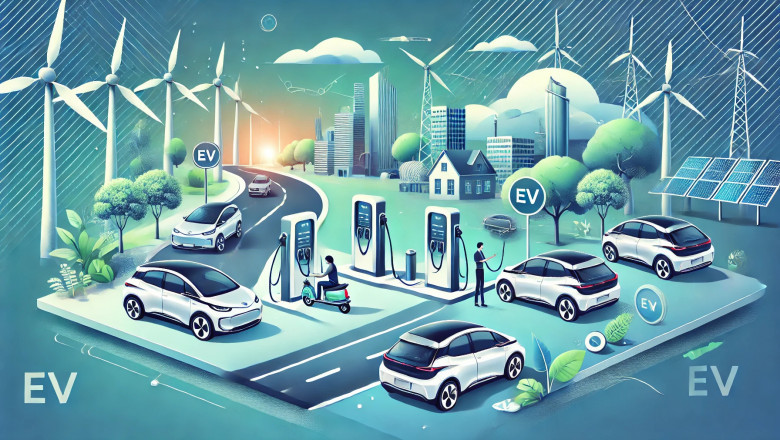views

The global electric vehicle (EV) market is accelerating toward a sustainable future, fueled by technological advancements, supportive policies, and changing consumer preferences. This article explores the latest trends shaping the EV market, its segmentations, and how industries are leveraging this growth to stay competitive.
Market Overview
The electric vehicle market has witnessed exponential growth in recent years, with global EV sales surpassing 10 million units in 2022. The market is expected to grow at a compound annual growth rate (CAGR) of 23.1% from 2024 to 2033, reaching a valuation of $1.5 trillion by 2033.
Key factors driving this growth include:
-
Stringent Emissions Regulations: Governments worldwide are pushing for lower carbon emissions, phasing out internal combustion engine (ICE) vehicles.
-
Technological Advancements: Improvements in battery technology and charging infrastructure are making EVs more accessible.
-
Rising Fuel Prices: Consumers are increasingly opting for cost-effective electric solutions over traditional fuels.
Upcoming Trends in the EV Market
Battery Innovation:
-
Solid-State Batteries: Offering higher energy density, faster charging, and improved safety, these are set to replace lithium-ion batteries in the next few years.
-
Cost Reductions: Battery costs are projected to drop below **$100 per kWh by 2025**, making EVs more affordable.
Expansion of Charging Infrastructure:
-
By 2030, the number of public EV chargers is expected to increase from 2 million in 2024 to 20 million globally.
-
Integration of ultra-fast chargers and wireless charging systems is revolutionizing convenience for EV users.
Vehicle-to-Grid (V2G) Technology:
-
EVs are becoming part of the energy ecosystem. V2G technology allows vehicles to store energy and feed it back into the grid, supporting renewable energy initiatives.
Autonomous EVs:
-
Self-driving electric cars and trucks are combining two revolutionary trends. Autonomous EVs are expected to see significant growth, with market penetration anticipated to reach 15% by 2030.
Commercial EVs:
-
Adoption of electric buses, trucks, and delivery vans is on the rise. Governments and businesses are investing in cleaner alternatives for public transport and logistics.
Request for a sample research report on the electric vehicle market
Electric Vehicle Market Segmentation
By Vehicle Type:
-
Passenger Vehicles
-
Commercial Vehicles
-
Two-Wheelers
By Propulsion Type:
-
Battery Electric Vehicles (BEVs)
-
Plug-in Hybrid Electric Vehicles (PHEVs)
-
Fuel Cell Electric Vehicles (FCEVs)
By Region:
-
North America
-
Europe
-
Asia-Pacific
-
Rest of the World
How Industries Are Leveraging EV Trends
Automotive: Traditional automakers are pivoting toward electric models. Companies like Ford, GM, and Volkswagen are committing billions of dollars to electrify their portfolios.
Energy and Utilities: Energy companies are collaborating with automakers to expand charging networks. They’re also exploring EVs as part of renewable energy storage solutions.
Technology: Tech giants like Google and Apple are entering the EV space, focusing on autonomous driving systems and connectivity.
Logistics and Transportation: Fleet operators like Amazon and DHL are adopting electric delivery vehicles, reducing operating costs and meeting sustainability goals.
Public Sector: Governments are driving change by investing in EV infrastructure, offering subsidies, and setting ambitious targets for phasing out ICE vehicles.
Get more insights on the Automotive Market Research Reports.
Market Challenges and Opportunities
Challenges:
-
High Initial Costs: Despite declining battery prices, EVs remain more expensive upfront than ICE vehicles.
-
Infrastructure Gaps: Uneven distribution of charging stations in rural areas hinders adoption.
-
Supply Chain Issues: Dependence on critical minerals like lithium and cobalt poses challenges.
Opportunities:
-
Battery Recycling: A growing market for recycling used batteries will address environmental concerns and resource scarcity.
-
Green Investments: Private and public funding for sustainable technologies is accelerating market growth.
-
Emerging Markets: Countries in Africa and Southeast Asia present untapped potential for EV adoption.
Conclusion
The electric vehicle industry is reshaping the automotive landscape and beyond, paving the way for a greener and more connected future. With advancements in battery technology, autonomous driving, and infrastructure development, the market is set to thrive in the coming decade.
As industries across automotive, energy, and logistics sectors capitalize on these trends, the global shift to electric mobility promises economic growth, environmental benefits, and a competitive edge for early adopters.






















Comments
0 comment